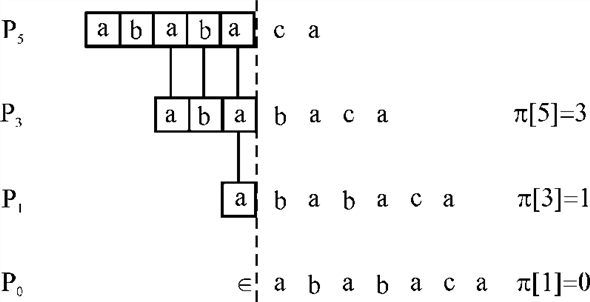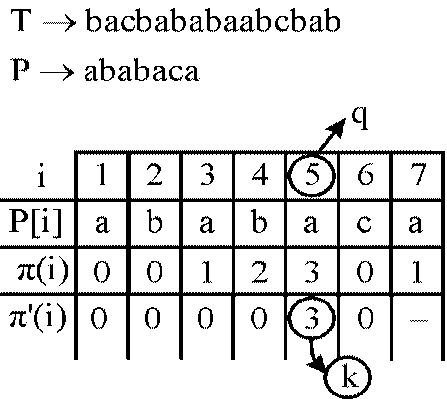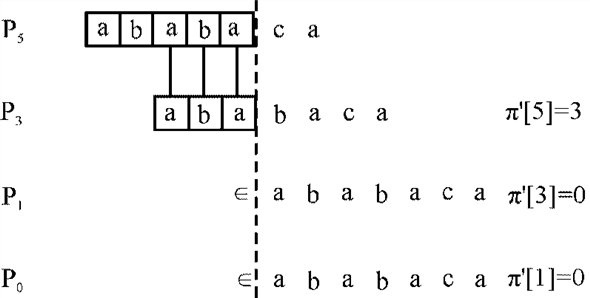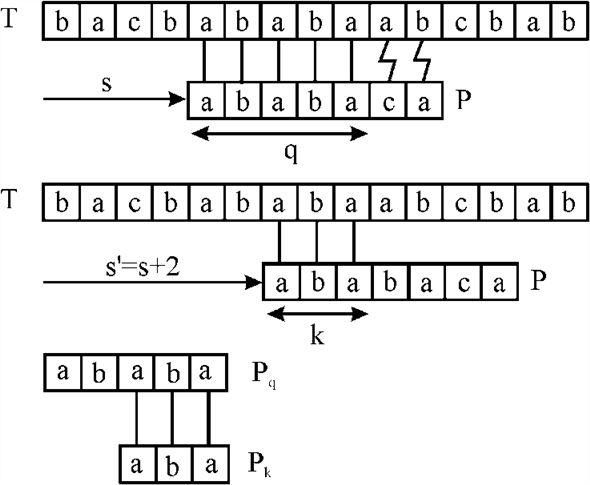The prefix function is used to determine how the pattern P matches itself. This testing is used while finding a pattern P in text T. It helps to avoid testing useless shifts.
The  is the
longest prefix length of P that has proper suffix
is the
longest prefix length of P that has proper suffix , where
q is the longest repetitive sequence in P.
, where
q is the longest repetitive sequence in P.
Suppose there is pattern .
.
The maximum value of q for this pattern is 7.
So, the  for this
pattern is 5. It is because the letter ‘ab’ repeats itself 5
times in pattern P.
for this
pattern is 5. It is because the letter ‘ab’ repeats itself 5
times in pattern P.
 ,
implies
,
implies .
.
This bound is tight; consider the following example to show that:
Suppose there is a pattern string in which letter a is
repeated q time that is .
.
Therefore, 
Also,  and so
on
and so
on
This implies 
Therefore, the upper bound on the size of  is
is  ,
which is the function of q .
,
which is the function of q .
The prefix  has the
information about how the pattern matches against the shifts of
itself.
has the
information about how the pattern matches against the shifts of
itself.
This information can be used to avoid testing useless shifts in
naive pattern matching algorithm or to avoid precomputation of
 for
a string matching automaton.
for
a string matching automaton.
Let the pattern P be “ababc” and the text T be “ababaabc”. Here, 4 characters have matched successfully but the 5th pattern character fails to match the corresponding text character.
The shifts in which the characters do not match are called invalid shifts.
In this figure the characters of the pattern P have matched with the text T and q denote the matching characters. In this case, the value of q is 4.

When a shift of  is taken,
which is a valid shift the matching will be done as follows:
is taken,
which is a valid shift the matching will be done as follows:
 and the value of k becomes 3.
and the value of k becomes 3.

Now, compare the matched patterns with itself and it is shown in the following manner:
The longest prefix of pattern P that is also a proper suffix of
 is
is
 .
.
Here the value of q in the first diagram is 4 because the four characters have matched and after shifting two positions to the right, in the second diagram the value of k is 3.
Therefore,  .
.
The next potential shift is at the position: 
Given pattern  , the prefix
function for pattern P is the function
, the prefix
function for pattern P is the function  :
:  such that
such that
 where
where
 is
the length of the longest prefix of P that is, a proper suffix of
is
the length of the longest prefix of P that is, a proper suffix of
 .
.
The complete prefix function  for the
pattern P: “ababaabc” is
for the
pattern P: “ababaabc” is
|
i |
1 |
2 |
3 |
4 |
5 |
6 |
7 |
8 |
|
|
a |
b |
a |
b |
a |
a |
b |
c |
|
|
0 |
0 |
1 |
2 |
3 |
4 |
5 |
0 |
Explaination:
• The Knuth-Morris and Pratt algorithm is used as its
computation time is linear and it uses an auxillary function
 precomputed from the pattern in time
precomputed from the pattern in time  .
.
• The auxillary function  allows the
transition function
allows the
transition function  to be
computed efficiently.
to be
computed efficiently.
•  contains
the information that is independent of a and is needed to
compute
contains
the information that is independent of a and is needed to
compute  .
.
• Thus, save a factor of  in
preprocessing time by computing
in
preprocessing time by computing  rather than
rather than
 .
.
To summarize it all, the simple way to achieve the result is to expand the alphabet one by one and if any character does not occur in either P or T, then compute the prefix array.
Proof showing that the running time of KMP-MATCHER is

Aggregate analysis is one of the methods of amortized analysis. Amortized analysis of an algorithm involves computing of maximum total number of all operations on the different type of data structures.
In amortized analysis the average of all the operations is computed by using the formula:

Where n is the total number of operations
Thus by this method the average cost of all operations remains the same and less expensive as compared to individual operations that might have high individual costs.
Using aggregate analysis it can be obtained the tighter bound of the algorithm
The Knuth-Morris-Pratt (KMP) algorithm is one of the best string
matching algorithms with its run time of 
Now KMP algorithm needs to be analyzed using aggregate analysis and find out its run time.
For this method, consider potential function to find out the order of each operation
Amortized cost = actual cost + potential difference
Here Actual cost is equal to the Initial cost of each operation
Potential difference: tradeoff or additional cost required for the operation when compared to the previous operation
According to formula,

Where i: denotes the ith operation
Idea of Approach
A single matching operation might take order of k that is
 and
for n operations the order would be:
and
for n operations the order would be:
Thus order is zero when n = 0 (when the string is already matched)
But, this is not a tighter bound hence the tighter bound would
be .
.
Now, average aggregate analysis of an operation can be found out by using:

Here the order of one operation can be found out by using the potential function and it is known for ‘n’ operations,
If the order is  then order
of an operation is
then order
of an operation is 
By using the converse, the order of one operation is known by using potential function. As the numbers of operations are ‘n’, the order is found out by multiplying the order of one operation and the number of operations ‘n’.
1.  : Initial
potential = 0 as no string has been matched before it
: Initial
potential = 0 as no string has been matched before it
 : It can
never be negative as number of strings matched can never be
negative
: It can
never be negative as number of strings matched can never be
negative
As per KMP algorithm if:

Where, p: denotes the pattern
t: denotes the text
Then using the amortized equation
. 
 , as one
comparison is known:
, as one
comparison is known:

Now using the equations

2. If
It implies that n number of times the shifting needs to be done n times to find the match
Then using the amortized equation
. 
 , as
n is the number of times until match is not found
, as
n is the number of times until match is not found

Where j denotes number of characters unused for match as per the cases in KMP algorithm
Now using the equation,

But,
 , since only
comparison
, since only
comparison
So,

Hence,
3. If
That is if  is greater
than
is greater
than 
Then using the amortized equation

// since no other shifts are necessary as already matched

Now using the equation,

But,
As
Since only one comparison,

So,

Since in all the three cases,

Amortized cost of i-th operation will be

Thus, cost of each operation is of .
.
Thus for ‘n’ operations the order would be that
is
that
is .
.
Hence, for KMP algorithm the tighter bound is obtained  by using the
aggregate analysis.
by using the
aggregate analysis.
Hence proved
Running time of KMP-MATCHER using potential function
Potential method is a part or method of amortized analysis. In
this method, the individual costs of the operations are to be found
out by finding 
Where n: number of operations
Amortized cost = actual cost + potential difference
Actual cost: initial cost of each operation
Potential difference: tradeoff or additional cost required for the operation when compared to the previous operation
According to formula,

Here i: denotes the ith operation
The Knuth-Morris-Pratt (KMP) algorithm is one of the best string
matching algorithms with its run time of 
NowKMP algorithm using aggregate analysis needs to be analyzed and run time is to be found.
 : Initial
potential = 0 as no string has been matched before it
: Initial
potential = 0 as no string has been matched before it
 : It can
never be negative as number of strings matched can never be
negative
: It can
never be negative as number of strings matched can never be
negative
1. As per KMP algorithm if:

Where,
p: denotes the pattern andt: denotes the text
Then using the amortized equation
. 
 , as one
comparison is done
, as one
comparison is done

Now using the equations

2. If 
It implies that shift n number of times shifting is to be performed to find the match
Then using the amortized equation
. 
 , as
n is the number of times until match is not found
, as
n is the number of times until match is not found

Where j denotes number of characters unused for match as per the cases in KMP algorithm
Now using the equation,

But,  , since only
comparison
, since only
comparison
So,

Hence,
3. If 
That is if  is greater
than
is greater
than 
Then using the amortized equation

// since no other shifts are necessary as already matched

Now using the equation,

But,
As 
Since only one comparison,

So,
Since in all the three cases,

Amortized cost of ith operation will be

As per our assumption as there are n operations
Hence, the amortized cost of KMP algorithm is 
Hence proved
KMP-MATCHING
It is an algorithm used for the pattern matching. The term pattern matching means that a pattern is searched in a given text. In the pattern matching, the searching has to be done for all of the occurrences of the pattern or one of it. It can be understood better by following example.
Text: abaaaaaaaabacccaba
Pattern: aba.
In this all the sub-string which has aba has to be searched. It has a wide range of applications as-editing of the text. A number of algorithms are used for this purpose as NAÏVE algorithm, KMP-algorithm. Here would be discussed the KMP algorithm. It is named after the scientist KNUTH-MORRIS-PRATT.
It is based on the string matching machine. It has the
improvement over the naive matching algorithm. It checks that the
pattern has matched or not. In this algorithm the movement should
be from one state to the next during the matching. In the process
the record of the state has to be kept to track the change that
occurs when there is mismatch. If here is an array of length
n for the text then total time taken is .
.
For KMP-MATCHER algorithm refer (section 32.3 of the textbook)
and here the modified form of the KMP-MATCHER is discussed in which
in the line 7 the  is replaced
by
is replaced
by  which is defined in a recursive way and its formulation is as
described below:
which is defined in a recursive way and its formulation is as
described below:

In the original algorithm the string has to be tested from left
to right and if during the process there is a match then the shift
will take place and if there is mismatch then the shift will not be
a valid one and the loop has to be tested again. And when  is replaced
by
is replaced
by  it does not
need to be shifted again and again. So, in this way the running
time increases and which reduces the time complexity.
it does not
need to be shifted again and again. So, in this way the running
time increases and which reduces the time complexity.
Explanation by implementation of both versions:
Consider the text T = bacbababaabcbab
Pattern P = ababaca
Now, according to the prefix function version of the text book, the table formed for a particular pattern and step wise shift operation shown below:


Now, according to the modified prefix function version of the KMP-MATCHER (according to the question), the table formed for a particular pattern and step wise shift operation shown below:

Here in above table the value of q and k are same as in older version that is 5 and 3 but here is shift operation perform only once but in the older version that are 3.

The diagrammatic representation of shift (s), q and k for the above text and pattern and also pattern itself has some character common.

Hence, the modified algorithm is correct and it improves the time complexity.
Cyclic Rotation in strings:
The cycle that exist in the string need to be identified. Existence of cyclic rotation in the string can be observed using the following example:
“structure”
“cturestru”
“urestruct”
All the three text sequences shown above form a part of cyclic rotation.
The following algorithm is the linear time algorithm to determine whether a text T is a cyclic rotation of another string T ’:
The logic for finding cyclic rotations is as follows:
• Concatenate the string T with itself.
• Check T’ is substring of TT or not.
• If T’ is a substring of TT, then T is a cyclic rotation of T’.
• If T’ is not a substring of TT, then T is not a cyclic rotation of T’.
Algorithm:
CYCLIC-CHECK(T, T ’)
1 // T is a main string and T’ is another string
2 if length(T)! = length(T’)
3 return false
4 for i = 0 to length(TT)
5 if(TT[i] = T ’[i])
6 count = count + 1
7 else
8 count = 0
9 if count = length(T’)
10 return true;
11 else
12 return false;
Time complexity calculations:
• The line 4 in the algorithm contains a loop and iterates
2n times if length of string T is n. So it
takes a time  .
.
• The remaining lines in the algorithm take constant time. So,
it takes  .
.
• The total running time of the algorithm is  .
.
Therefore, the total running time of the algorithm
CYCLIC-CHECK( T , T ’)
is  .
.
For example:
T=“structure”
T’=“cturestru”
Both strings have the same length, so
Concatenating, TT becomes “structurestructure”
Now checking that if T’ is the substring of TT, it returns true.
In this particular example it is:

So, T is a cyclic rotation of another string T’.
To compute the transition function  for the
string-matching automaton:
for the
string-matching automaton:
Transition function is generally computed in . But, the
transition function can be computed in
. But, the
transition function can be computed in  by
efficiently using the algorithm.
by
efficiently using the algorithm.
Now, trying to find out the algorithm that can compute the
transition function of a string matching algorithm having pattern
p has time complexity of .
.
Use the hint in the problem.
Assume, that  has been
computed (it is the prefix function as defined in KMP
algorithm).
has been
computed (it is the prefix function as defined in KMP
algorithm).
Now, compute , using the
below algorithm,
, using the
below algorithm,
COMPUTE-PRE-FIX-FUNCTION (P)
1 len = P.length
2 let  [1...
len] be a new array
[1...
len] be a new array
3  [l] = 0
[l] = 0
4 k = 0
5 for q = 2 to len
6 while k> 0 and P[k+1] P[q]
P[q]
7 k=  [k]
[k]
8 if P[k + 1] == p[q]
9 k=k+1
10  [q]
= k
[q]
= k
11 return
Now, the value  needs to be
calculated which is the state that has to be gone through. If the
current input character is x and the stage is q and
current character is P[q], control moves to next
stage, which is q+1 because the character at this stage is
matched.
needs to be
calculated which is the state that has to be gone through. If the
current input character is x and the stage is q and
current character is P[q], control moves to next
stage, which is q+1 because the character at this stage is
matched.
So 
Whenever the condition given above does not match, the tracing of stage having lower number p[q] is there. This makes the state before q, which is last state p [0 ... p[q]] as a suffix of p [0 ... q].
So at state the q, its output contains the outputs of state p[q]. It is because the outputs are copied to the state q. As The character p[i] is set previously, this will be copied.
Modified Algorithm:
COMPUTE_TRANSITION_FUNCTION (P, )
)
//Store the length of the string in variable m
1 len = length (P);
2 for q = 0 through m
do
{
3 for each character x in 
// make increment of +1 for x, and increment of +2 for subsequent repeat
// loop to decrement. Finding minimum len+1, q+2 and store in k
4k = min (len+1, q+2);
// from here working of backward starts from q+1
5 repeat k = k-1
6 until  (k)
is-suffix-of'
(k)
is-suffix-of'  (q);
(q);
// operation of assigning the transition table occurs here
 (q,
x) = k;
(q,
x) = k;
}
7 end for;
Return  ;
;
Thus, the required state is got that needs to be gone through and modification part is on step6.
Complexity of the algorithm:
Step 1 and step 7 are of complexity .
.
Steps 2, 3, 4, 5, 6 are of 
On finding the complexity throughout the algorithm the result,

On keeping a tighter bound the complexity is 
Hence proved


